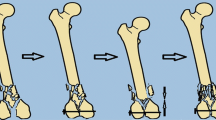Abstract
Objective
This study aimed to propose treatment protocol and identify patterns of tillaux fractures using three-dimensional (3D) computed tomography (CT) analysis and to describe an effective reduction technique.
Methods
Forty-two juvenile patients with tillaux fractures were evaluated with 3D-CT scan for fracture displacement pattern and received surgical treatment. Tillaux fragment was reduced by pushing the superomedial quadrant part of the fragment slightly downward towards the ankle joint from anterolateral to posteromedial through 5-mm skin incisions with mosquito forceps. A 4.0 cannulated screw was subsequently inserted from the anterolateral to the posteromedial side parallel to the ankle joint. We analysed the distance and direction of fracture displacement with 3D-CT before the surgery. Pre-operative and post-operative plain radiographs were evaluated.
Results
Pre-operative 3D-CT analysis revealed a common fracture pattern, varus tilt, and external rotation of fragment. We achieved satisfactory reduction with residual fracture gaps less than 2 mm in 42 cases. Two cases had a 13-mm anterior gap that was reduced by mini-open reduction because of periosteal im**ement. No significant clinical complications were found.
Conclusion
The closed reduction technique developed based on the fracture pattern identified by 3D-CT anatomical analysis is safe and effective in treating tillaux fractures.






Similar content being viewed by others
References
Mizuta T, Benson WM, Foster BK, Paterson DC, Morris LL (1987) Statistical analysis of the incidence of physeal injuries. J Pediatr Orthop 7:518–523
Tiefenboeck TM, Binder H, Joestl J, Tiefenboeck MM, Boesmueller S, Krestan C et al (2017) Displaced juvenile tillaux fractures: surgical treatment and outcome. Wien Klin Wochenschr 129(March (5–6)):169–175
Ayas MS, Köse A, Terzi E, Dincer R, Topal M, Uymur EY, Şahin A (2021) Surgical management of displaced adolescent tillaux fractures with the mini-open technique. Ulus Travma Acil Cerrahi Derg. 27(1):109–114
Kim JR, Song KH, Song KJ, Lee HS (2010) Treatment outcomes of triplane and tillaux fractures of the ankle in adolescence. Clin Orthop Surg 2:34–38
Leary JT, Handling M, Talerico M, Yong L, Bowe JA (2009) Physeal fractures of the distal tibia: predictive factors of premature physeal closure and growth arrest. J Pediatr Orthop 29:356–361
Tak S, Qureshi MK, Ackland JA, Arshad R, Salim J (2021) Adolescent tillaux fractures: a systematic review of the literature. Cureus 13(1):e12860
Kaya A, Altay T, Ozturk H, Karapinar L (2007) Open reduction and internal fixation in displaced juvenile tillaux fractures. Injury 38:201–205
Duchesneau S, Fallat LM (1996) The tillaux fracture. J Foot Ankle Surg 35:127–133
Wuerz TH, Gurd DP (2013) Pediatric physeal ankle fracture. J Am Acad Orthop Surg 21:234–244
Tanaka M, Shibano K, Tagawa Y, Kawai H, Hamada M (2009) Juvenile tillaux fracture with disrupted anteroinferior tibiofibular ligament: a case report. Knee Surg Sports Traumatol Arthrosc 17:1239–1242
Kennedy MA, Sama AE, Padavan S (1998) The tillaux fracture: a case report. J Emerg Med 16:603–606
Miller MD (1997) Arthroscopically assisted reduction and fixation of an adult tillaux fracture of the ankle. Arthroscopy 13:117–119
Panagopoulos A, van Niekerk L (2007) Arthroscopic assisted reduction and fixation of a juvenile tillaux fracture. Knee Surg Sports Traumatol Arthrosc 15:415–417
Choudhry IK, Wall EJ, Eismann EA, Crawford AH, Wilson L (2014) Functional outcome analysis of triplane and tillaux fractures after closed reduction and percutaneous fixation. J Pediatr Orthop 34:139–143
Schlesinger I, Wedge JH (1993) Percutaneous reduction and fixation of displaced juvenile tillaux fractures: a new surgical technique. J Pediatr Orthop 13:389–391
Crawford AH (2012) Triplane and tillaux fractures: Is a 2 mm residual gap acceptable? J Pediatr Orthop 32:S69-73
Cooperman DR, Spiegel PG, Laros GS (1978) Tibial fractures involving the ankle in children. The so-called triplane epiphyseal fracture. J Bone Joint Surg Am 60:1040–1046
Ertl JP, Barrack RL, Alexander AH, VanBuecken K (1988) Triplane fracture of the distal tibial epiphysis. Long-term follow-up. J Bone Joint Surg Am 70:967–976
Spiegel PG, Cooperman DR, Laros GS (1978) Epiphyseal fractures of the distal ends of the tibia and fibula. A retrospective study of two hundred and thirty-seven cases in children. J Bone Joint Surg Am 60:1046–1050
Horn BD, Crisci K, Krug M, Pizzutillo PD, MacEwen GD (2001) Radiologic evaluation of juvenile tillaux fractures of the distal tibia. J Pediatr Orthop 21:162–164
Funding
The authors did not receive support from any organization for the submitted work.
Author information
Authors and Affiliations
Corresponding author
Ethics declarations
Conflicts of interest
The authors report no conflict of interest.
Additional information
Publisher's Note
Springer Nature remains neutral with regard to jurisdictional claims in published maps and institutional affiliations.
Rights and permissions
Springer Nature or its licensor (e.g. a society or other partner) holds exclusive rights to this article under a publishing agreement with the author(s) or other rightsholder(s); author self-archiving of the accepted manuscript version of this article is solely governed by the terms of such publishing agreement and applicable law.
About this article
Cite this article
Lee, J.W., Cho, J.H., Song, H.K. et al. Closed reduction and internal fixation for tillaux fractures, based on pre-operative three-dimensional computed tomography. Eur J Orthop Surg Traumatol (2024). https://doi.org/10.1007/s00590-024-03910-0
Received:
Accepted:
Published:
DOI: https://doi.org/10.1007/s00590-024-03910-0




